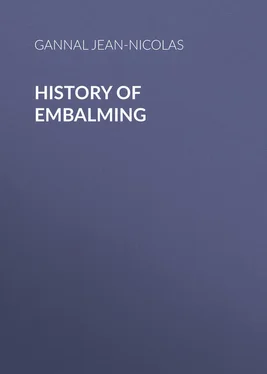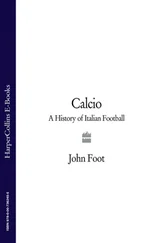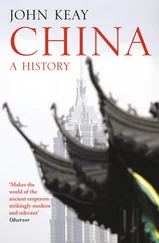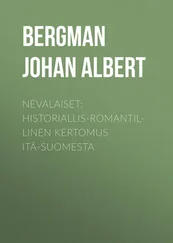Jean-Nicolas Gannal - History of Embalming
Здесь есть возможность читать онлайн «Jean-Nicolas Gannal - History of Embalming» — ознакомительный отрывок электронной книги совершенно бесплатно, а после прочтения отрывка купить полную версию. В некоторых случаях можно слушать аудио, скачать через торрент в формате fb2 и присутствует краткое содержание. Жанр: foreign_antique, foreign_prose, на английском языке. Описание произведения, (предисловие) а так же отзывы посетителей доступны на портале библиотеки ЛибКат.
- Название:History of Embalming
- Автор:
- Жанр:
- Год:неизвестен
- ISBN:нет данных
- Рейтинг книги:5 / 5. Голосов: 1
-
Избранное:Добавить в избранное
- Отзывы:
-
Ваша оценка:
- 100
- 1
- 2
- 3
- 4
- 5
History of Embalming: краткое содержание, описание и аннотация
Предлагаем к чтению аннотацию, описание, краткое содержание или предисловие (зависит от того, что написал сам автор книги «History of Embalming»). Если вы не нашли необходимую информацию о книге — напишите в комментариях, мы постараемся отыскать её.
History of Embalming — читать онлайн ознакомительный отрывок
Ниже представлен текст книги, разбитый по страницам. Система сохранения места последней прочитанной страницы, позволяет с удобством читать онлайн бесплатно книгу «History of Embalming», без необходимости каждый раз заново искать на чём Вы остановились. Поставьте закладку, и сможете в любой момент перейти на страницу, на которой закончили чтение.
Интервал:
Закладка:
In order to preserve the bodies of his own image, man, stimulated by sentiments of religion, respect, or of love, mutilates in vain their inanimate spoils; in vain he penetrates with aromatics and preservative juices, remains, which putrefaction reclaims and seizes. Nature covers with a little snow the traveller who scales the mountain, then, after centuries, returns the body unaltered. She commands the winds to blow: the sands of the desert are agitated, and the soldiers of Cambyses, and the soldiers of Alexander, are dried in the dust; penetrating with some unknown bodies the entrails of the earth, she there preserves the generations which have preceded us.
Here is the art of embalming in its highest degree of perfection; here are mummies which we ought to desire to imitate. It must be acknowledged, that when the Egyptians and the Guanches transmitted to us their bodies in a state of preservation, which has been the admiration and astonishment of ages, they owed as much, at least, to the aid of nature, as to the perfection of their art, and the development of their industry. If, then, we wish to preserve the bodies of those who excited our admiration or our love, in place of despising the mummies 9 9 The reverend Father Kircher in his chapter on mummies, thinks that these bodies do not merit the name; here is what he says in his chapter iii, §. 2. “But these bodies, dried and preserved in the sands of Lybia, should not receive the name of mummy , because a mummy is, properly speaking, a body prepared after a special process.” Such ideas have caused much empyricism, and have been most powerful obstacles to the progress of the art of embalming.
which nature presents us with, let us study them, let us seek with care, the cause of their preservation, and, by reasonable analyses, let us endeavour to penetrate the secret of her ways.
If this direction had been followed, convenient processes would doubtless have been discovered a long time ago; and it never would have been supposed possible to preserve a corpse with certainty, by stuffing it with sixty or eighty kinds of powdered aromatics. After such considerations, we, who have substituted an experimental for an empyrical method, and progressed from the known to the unknown, ought, to be consistent, to study natural mummies first.
Some have been formed by the general qualities of the air and earth, others, by purely local influences; in the first series, we include the mummy of the sand, and those of avalanches; in the second, those discovered here and there in certain sepultures; in the convent of the Capuchins, near Palermo; in the caves of St. Michel, at Bordeaux; in the cemetery of the church of Saint Nicholas; the Museum; the cloister of the Carmes; the caves of the Jacobins and the Cordeliers, at Toulouse, &c.
These last named mummies, the preservation of which is probably due to the particular properties of the soil in which they were deposited, have been, up to the present day, objects of vulgar curiosity, rather than of attentive examination.
Drs. Boucherie, Bermont, and Gaubert, have favoured me with some notes taken during a visit to the caves of St. Michel, at Bordeaux, ( August , 1837.) I let them speak for themselves:
“The bodies exposed to view at Bordeaux, in the cavern situated beneath the tower of Saint Michel, were deposited there in 1793, nearly in the same state in which they appear at present, they came from the sepulchres of the church and the adjoining cemetery. A great number of bones, and the wreck of soft parts, dried and preserved like the whole bodies, form a layer of seventeen or eighteen feet, upon which are supported the inferior extremities of seventy subjects, arranged in a circle around the wall, and retained in a vertical position by the cords which bind them. Some of these, they say, had remained in the earth many centuries, others from sixty to eighty years or more.
“During our visit, 25th August, 1837, we determined to examine with care the state of these bodies, those of the middle, where they had remained for more than forty years, and above all, we procured strips of skin and muscle, in order to examine them at leisure, and to submit them to some chemical re-agent, which might reveal to us the presence of the preservative element. We could not hope to collect any of the earth that had originally covered them, since they were superposed on remnants thrown into this place at the time they were enclosed here.
“After having furnished ourselves with a thermometer at 24° R., and a hygrometer at 34°, both in the open air, we descended thirty or forty steps, which conducted us to the cave. The coolness did not appear to us very striking, as it commonly is at this depth during the heat of the dog-star. Placing our instruments on the soil, we proceeded to examine the bodies.
“It is an extraordinary aspect, by lamp-light, offered by this circular space, the walls of which are tapistried by dead bodies all standing erect; the eye wanders from one to the other involuntarily, and we view the whole before confining ourselves to details. Although the most of them are in the attitude of the buried dead, some differences in size, in the position and expression of the physiognomy, produce a strange and confused impression. There is one point, however, where our regards were particularly attracted, where the heart is chilled and troubled with deep emotion – here is beheld a miserable creature in a position violently contracted – the mouth open and horribly contracted, the inferior members strongly drawn to the body – the arms, one twisted by convulsions is thrown over the head, the other folded beneath the trunk, and fixed to the thigh by the nails, which are deeply implanted in the flesh; the forced inflexion of the whole body, gives the expression of ineffable pain, all announcing a violent death. Unfortunate wretch! had he died in this state, or rather, had he been buried alive, and assumed this position in the horrible agonies of awakening?
“The skin of all these mummies, of a more or less deep gray colour, dried and rather soft to the touch, gives the sensation of parchment slightly stretched upon the organs, dried, and of the consistence of amadou 10 10 A sort of tinder made of agaric. — Tr.
or spunk; the articulations are stiff and inflexible; the chest, the abdomen, and the cranium, examined carefully, did not show any incision, any regular opening indicative of any trace of embalming, even the most imperfect. The different features of the face, still distinct among some of them, displayed a variety of physiognomy; two or three of them displayed the hair of the beard very well preserved, the teeth were healthy and covered with brilliant enamel. The upper and lower extremities entirely dried, and whole in many of the subjects, are provided with all the phalanges; the last, however, divested of its nail. On the body of the tallest figure is perceived enormous purses, with evident traces of a double scrotal hernia. The skin raised and viewed on its interior surface, is tanned like the exterior; all traces of cellular tissue has disappeared; the muscles, separated from the skin, have the colour and consistence, and almost the internal structure of amadou. On introducing the hand into the chest, some rudiment of lung was found, a net work very similar to that of leaves deprived of their fleshy part; they might be taken for a mass of leaves dissected by the caterpillars, and rendered adherent by the threads and viscous fluid that these insects deposit. The intestines, also dried, are nearly in the same state.
“Such are the principal details which presented themselves in the course of our examination: at first sight, it appeared astonishing that these bodies, removed for more than forty years from the medium in which they were desiccated, should have experienced no sensible alteration in a cavern situated deeply under the earth, and surmounted by a structure like that of the tower of St. Michel. Let us return to our instruments, perhaps they will aid us in the explanation of the fact. After remaining an hour in this atmosphere, the thermometer passed from 24° to 18°, and the hygrometer, from 34° to 42°, which gives a difference for the first, of 6°, for the second of 8°, a very trifling difference, when compared to that of caves and other places in the same apparent position. This thermometrical and hygrometrical state of the air, always invariable, is, without doubt, one of the principal circumstances in maintaining the integrity of these mummies. To what cause, further, can be attributed this double state of the air in the cavern? A slow fermentation, movements of latent decomposition in the enormous mass of animal remains which form the bottom of this receptacle, are they not the probable cause? We think so, and we leave with confidence this idea, to the meditation of philosophers. Our end was attained, we had proved facts, and collected some parcels of the remains to subject them to analysis; after different trials without result, some portions of skin and muscular tissue, placed in weakened hydrochloric acid, and treated by ebullition, were totally dissolved in this liquid, to which they communicated a deep brown colour. This liquor filtered and treated by the yellow cyanate of potash, yielded a very abundant blue precipitate; and the presence of iron was thus indicated, from whence we thought that the preservation of these bodies was owing to the presence of a compound of iron in the earth, where they had been deposited. But the human blood yields iron also; was it a portion of this element of our tissues that our experiments brought into play? A suit of comparative experiments upon the tissues of mummies, on the one hand, and of the same tissues dried in the sun of subjects recently dead, on the other hand, have evidently proved the excess of iron in the first. Analogous circumstances doubtless, have determined the preservation of the bodies found at Toulouse, at Palermo, &c. We regret not to be able to transmit the suit of experiments made by our learned friend, Dr. Boucherie; these will form the subject of ulterior researches.”
Читать дальшеИнтервал:
Закладка:
Похожие книги на «History of Embalming»
Представляем Вашему вниманию похожие книги на «History of Embalming» списком для выбора. Мы отобрали схожую по названию и смыслу литературу в надежде предоставить читателям больше вариантов отыскать новые, интересные, ещё непрочитанные произведения.
Обсуждение, отзывы о книге «History of Embalming» и просто собственные мнения читателей. Оставьте ваши комментарии, напишите, что Вы думаете о произведении, его смысле или главных героях. Укажите что конкретно понравилось, а что нет, и почему Вы так считаете.












